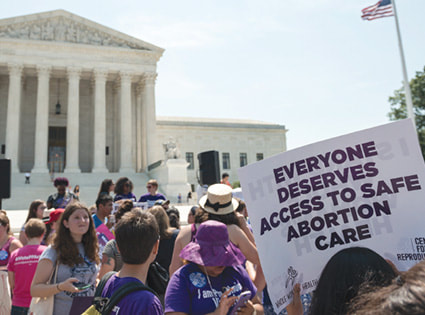The Reversal of Roe vs. Wade will decrease healthcare and increase deaths
On June 22 of 2022, I woke up to the news that Roe vs. Wade had been overturned by the Supreme Court. My heart plummeted, as I realized how many lives had been changed forever. Overnight, the case which found restrictive state regulation on abortion unconstitutional under the 14th amendment for over 50 years, was cast down. After the draft opinion which eventually became reality was leaked, an article published by the New York Times on May 7th, 2022, found that out of the 64 million women and girls of reproductive age in the United States, around 33.6 million, were found to be at risk of losing their right to abortion if Roe vs. Wade fell. This risk is now a reality. As of July 2nd, abortion is banned in South Dakota, Wisconsin, Missouri, West Virginia, Alabama, Arkansas, Oklahoma, and Texas.
This list is not the whole country. Abortion is still available, as it was previously, in parts of the United States, but the price tag on reproductive healthcare just skyrocketed. Alaska, for instance, is one of the states that has protected abortion under its constitution specifically through the Valley Hospital Association v. Mat-Su Coalition for Choice, and the State v. Planned Parenthood of Alaska cases. Even when abortion is protected, the process to get one can be challenging. In Alaska parents of patients under 18 must be notified and patients must also receive counseling that forces them to confront the worst-case scenarios related to abortion. Nevertheless, Alaskans are still lucky. In states where abortion isn’t legally protected, patients seeking abortions may have to travel long distances to obtain one. According to data collected from Guttmacher Institute, the national average distance traveled to obtain an abortion in the U.S is 276 miles. A patient more than 20 weeks pregnant in California would have to travel 9 miles to obtain an abortion, and in Louisiana, the distance is 71 miles. In Arkansas, the distance is 160 miles and grows to 328 miles when someone is 22 weeks pregnant. In 2014, the Guttmacher Institute found that, out of all the people who obtained abortions, 49% were living under the federal poverty line, 53% paid for their abortion out of pocket, 60% were in their 20s, and 59% had already given birth. These numbers don’t reflect a group with resources, or a group made up of exclusively atheists, or liberals who vote democrat in need of abortions. All types of people get abortions because all people need healthcare. According to the Centers for Disease Control, in 2020, there were 23.8 deaths for every 100,000 live births in the U.S. This number is exponentially greater than what it is in other developed countries. Abortion is used to minimize this number and save those who experience conditions like ectopic pregnancy which can be deadly. After the end of Roe, in states where only medically necessary abortions are legal, the probability that patients will die while doctors navigate legal issues will increase. A risky pregnancy doesn’t wait for lawyers, and pregnancy can be dangerous. It is impossible to ban all abortions, you can only ban safe abortions. According to the Guttmacher Institute, in parts of the world where abortion is restricted 30,000 deaths are caused by illegal abortions yearly. The rates of abortions are also higher in countries where access is limited. Abortions won’t stop. Desperation will occur and people will die from seeking unsafe and unregulated abortions. The U.S isn’t exempt from this. Data published by the CDC between 1972 and 1974, before and after Roe vs. Wade was established, found that the number of deaths associated with illegal abortions went from 39 to 5 after abortion was constitutionally protected. Reality is clear, when people lose access to healthcare, they die, and the supreme court justices who voted to overturn Roe vs. Wade chose to ignore this. |
